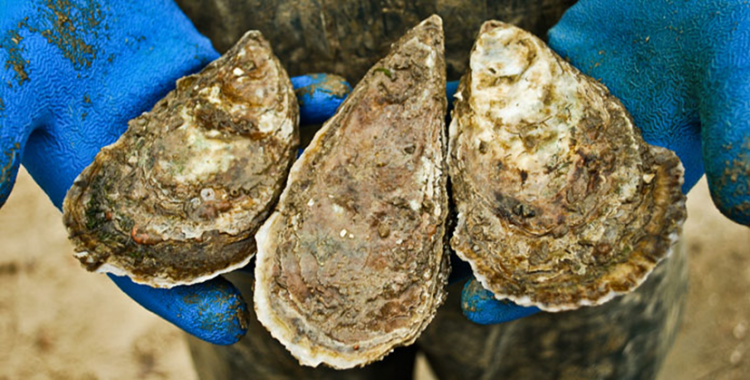This week the Chesapeake Bay Program and its partners approved the Oyster Best Management Practices Expert Panel’s first recommendations on specific oyster aquaculture practices that remove excess nitrogen and phosphorus from Chesapeake Bay. The recommendations are intended to become best management practices in support of the Chesapeake Bay Total Maximum Daily Load, pollution limits established by the U.S. Environmental Protection Agency to ensure clean water in the bay.
Scientists from NCCOS and NOAA’s Northeast Fisheries Science Center have served on the Oyster Best Management Practices Expert Panel since September 2016. The 13-member panel, which reports to the Chesapeake Bay Program and is coordinated by the Oyster Recovery Partnership, evaluated the potential and feasibility of using oysters as best management practices for nutrient reduction in Chesapeake Bay and recommended crediting and verification guidelines for application in meeting the water quality goals established by the Chesapeake Bay Total Maximum Daily Load.

The panel worked with stakeholders to identify and define oyster practices (e.g., aquaculture, restoration) that reduce nutrients and suspended sediment, evaluated whether existing science confirms reduction effectiveness, developed a nutrient and suspended sediment pollutant reduction effectiveness determination decision framework, and is using the framework to provide reduction effectiveness estimates for one or more oyster best management practices.These first recommendations include assimilation of nitrogen and phosphorus in oyster tissue only. Evaluation for crediting of shell, denitrification, and burial in sediment will continue with recommendations anticipated in late 2017.
For more information, contact Suzanne.Bricker@noaa.gov or Julie.Rose@noaa.gov, or visit http://www.oysterrecovery.org.
Related Project Pages:
- Shellfish Aquaculture and Payment for Ecosystem Services in Chesapeake Bay
- National Estuarine Eutrophication Assessment: Update
- AquaSpace – An Ecosystem Approach to Making Space for Sustainable Aquaculture
- Planning for Sustainable Shellfish Aquaculture in Complex Multiple Use Environments: Determining Social and Ecological Carrying Capacity for South Puget Sound (PECSA)
- Aquaculture and Eutrophication in Long Island Sound and Great Bay – Piscataqua Estuary
- Improved Aquaculture Decision-making Using the Aquaculture Mapping Atlas and FARM Model
Related News:
Shellfish Aquaculture Planning Models:
- Assessment of Estuarine Trophic Status [ASSETS] eutrophication model
- Farm Aquaculture Resource Management [FARM] shellfish aquaculture model
